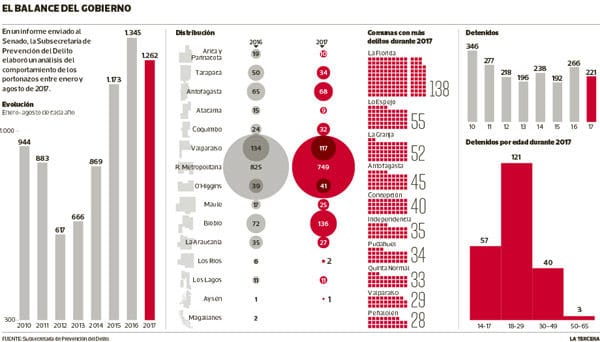A Racial Introduction to Chile, Part III
Benjamin Villaroel, American Renaissance, September 7, 2018

This is the third of a three-part series. Here is part one. Here is part two.
The challenge of our time
This racial sketch of Chile is admittedly rough — government statistics from Latin American and Mediterranean countries are not as precise as those of Nordic, Germanic, and Anglo countries. I am confident that for each number and statistic I have cited, a conflicting one, varying by as much as 20 percent, could be found. On the whole, though, I have provided a good basis for understanding race in Chile up until a few years ago. Since then, change has been rapid, and it is important to understand the dramatic impact of Chile’s newer immigrants. Last year on this website, Gustavo Semeria thoroughly documented the demographic suicide Argentina slowly but surely embarked upon several decades ago. Tragically, Chile may have set itself on the same path.
The most defining trend of our era is the movement of non-whites — envious of the prosperous and stable societies created by whites — flooding into and fundamentally transforming white societies. This is the century of Camp of the Saints. Chile is in no way immune from this trend. In the last 20 years, and especially the last five, non-white immigration to Chile has increased dramatically. “Dramatically” is perhaps an understatement. As of 2017, 1,119,267 people living in Chile were foreign-born. Chile is not a large nation, and this represents 6.1 percent of the total population. The most common countries of origin are: Peru (23.8 percent), Colombia (13 percent), Venezuela (12 percent), Bolivia (11 percent), Haiti (10 percent), Argentina (7.9 percent), and Ecuador (3.5 percent). Just as with the United States, only in the 1970s did non-European immigration outstrip European immigration in Chile:
| Year | Total population | Immigrant population | ||||
|---|---|---|---|---|---|---|
| Total | Percent of total population | Percent from Europe | Percent from the Western Hemisphere | Percent from elsewhere | ||
| 1865 | 1,819,223 | 21,982 | 1.21 | 53.7 | 41.4 | 4.9 |
| 1875 | 2,075,971 | 25,199 | 1.21 | 62.3 | 33.0 | 4.7 |
| 1885 | 2,057,005 | 87,077 | 4.23 | 30.1 | 67.2 | 2.7 |
| 1907 | 3,249,279 | 134,524 | 4.50 | 53.3 | 42.7 | 4.0 |
| 1920 | 3,731,593 | 114,114 | 3.06 | 60.0 | 31.2 | 8.9 |
| 1930 | 4,287,445 | 105,463 | 2.46 | 60.0 | 24.6 | 15.4 |
| 1940 | 5,023,539 | 107,273 | 2.14 | 67.2 | 21.7 | 11.1 |
| 1952 | 5,932,995 | 103,878 | 1.75 | 55.9 | 23.4 | 20.7 |
| 1960 | 7,374,115 | 104,853 | 1.42 | 60.9 | 26.1 | 13.0 |
| 1970 | 8,884,768 | 90,441 | 1.02 | 53.3 | 34.4 | 12.3 |
| 1982 | 11,275,440 | 84,345 | 0.75 | 31.8 | 54.5 | 13.7 |
| 1992 | 13,348,401 | 114,597 | 0.86 | 20.1 | 65.1 | 14.8 |
| 2002 | 15,116,435 | 184,464 | 1.22 | 17.2 | 71.8 | 11.0 |
| 2012 | 16,634,603 | 339,536 | 2.04 | 10.5 | 85.6 | 3.8 |
| 2017 | 17,574,003 | 1,119,267 | 6.1 | 12.4 | 83.8 | 3.8 |
As the above table shows, immigrants became less white just as their overall numbers increased enormously. In the 10 years from 2002 to 2012, the immigrant population increased 84 percent. From 2012 to 2017 the immigrant population relative to 2012 — in just half the time — increased 229 percent. On top of these official figures, there are an estimated 300,000 “irregular” (i.e. illegal) immigrants in Chile today — mostly Peruvians and Bolivians who have sneaked across the border, and Haitians who have overstayed their visas. Government statistics and tallies are not as precise in Chile as in the United States, and should be viewed with some skepticism, but the general trend is clear.
It is understandable that immigrants from less successful South American countries try to come to Chile in large numbers, but how do people from Haiti — with no land border and no common language — end up in Chile? There may be a criminal racket behind the recent surge. Haitians in Haiti are buying fake letters purporting to be from Chilean churches and charities promising housing and jobs. They then board flights for Chile without knowing any Spanish, show these letters to customs agents, register as visitors, and disappear. The main company doing this is Latin American Wings, which for a time was bringing 100 Haitians to Chile every day. Just as in the West, there are plenty of companies in Chile all too happy to put profit before race, and in Chile, Latin American Wings is certainly the biggest offender on this account.
From the data available from a wide array of sources, I have put together the below table showing the number of foreign-born Chileans by country over the years. Data weren’t available for every year.
| Peruvians | Bolivians | Columbians | Haitians | Argentines | Ecuadorians | |
|---|---|---|---|---|---|---|
| 1960 | 3,583 | 645 | 11,876 | |||
| 1982 | 4,308 | 1,069 | 19,733 | |||
| 1990 | 7,277 | |||||
| 1992 | 7,649 | 1,666 | 34,415 | |||
| 2002 | 37,860 | 10,919 | 4,095 | 50 | 48,176 | 9,393 |
| 2012 | 103,624 | 25,121 | 27,411 | 57,019 | 16,357 | |
| 2013 | 117,925 | 33,623 | 48,894 | 2,428 | 53,192 | |
| 2015 | 130,361 | 37,554 | 63,481 | 55,185 | ||
| 2016 | 48,783 | |||||
| 2017 | 266,244 | 122,773 | 145,139 | 112,414 | 87,926 | 39,556 |
Other smaller, but not insignificant foreign national populations, as of 2017, include: Spanish (26,177), Brazilian (20,707), American (19,900), Chinese (17,021), and Dominican (9,270). The total number of foreigners from all other nations was a sizable 117,750.
The biggest difficulty in determining the racial makeup of Chile is that although the government monitors the foreign/immigrant population, it does not classify by race — except for Amerindians. The broad and imprecise nature of whiteness in Chile means that the government does not distinguish between the southern Chilean castizo and the notably darker mestizos of the north. Up until recently, this has not been a very big issue because there was little mestizo immigration, but with increasing arrivals of Peruvians, Bolivians, etc., it is time to adopt better racial categories for its census. For example, we know how many people born in Peru are now in Chile, but we do not know their birth rates, their rates of intermarriage with castizo Chileans, etc.
It is certain, however, that Chile is darkening. The enormous increases in non-white immigration, as shown in the above tables, makes this inevitable. At the same time, Chile’s birth rate is nearly as bad as the notoriously infertile West: about 13 per 1,000 citizens. Belgium, Denmark, and Norway are 11; Germany, Spain, and Greece are 9. At the other end of the scale, Peru and Bangladesh are 19; Bolivia and Cambodia are 23; Nigeria and Mozambique are 39. There has been considerable discussion at American Renaissance, and other dissident websites, about the “world’s most important graph,” that shows the UN’s demographic projections over the course of the next century.
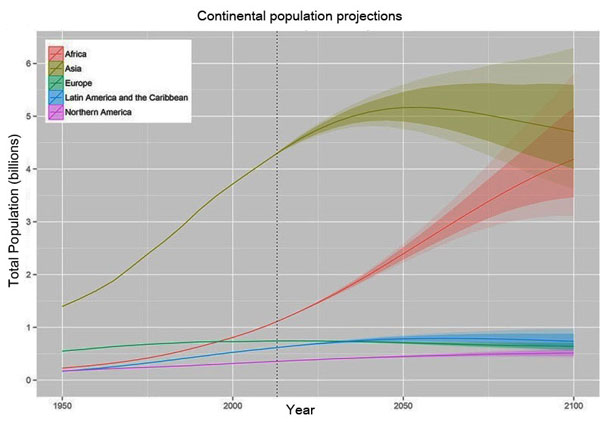
It is little appreciated, however, that these projections will be just as devastating to the “off white” parts of the world as to the white ones. The Arab and Turkic nations of North Africa and Asia may be overwhelmed by sub-Saharan blacks. Meanwhile, if nothing is done, Latin America’s whitish “Southern Cone,” consisting of Chile, Argentina, and Uruguay, will be flooded with mestizos, Amerindians, and many blacks and Asians as well. The limited data on Chilean group birthrates that is available suggests that, like nearly every country in the West, immigrants have much higher birthrate than the natives, particularly Colombians, Chinese, and Venezuelans. We should be grateful that it is not Bolivians and Haitians that are having the most children.
Troublesome trends
So far, the worst result of these demographic shifts is that for the first time in its history Chile has a large black minority, composed mostly of Haitians, but also of black Colombians and a few black Peruvians and Bolivians. According to Richard Lynn and Tatu Vanhanen’s book, IQ and the Wealth of Nations, Chile has an average IQ of 90. To put that in context, consider these data points:
- Latin America’s two other whitish nations (which are, admittedly, whiter than Chile), Uruguay and Argentina, are 96 and 93, respectively.
- The average IQs of Spain and Portugal are 98 and 95, respectively.
- Two other countries with an average IQ of 90 are also what might be considered “off white” — albeit of a very different variety — Turkey and Kyrgyzstan.
- Chile’s upper class is very white, composed of immigrants from European nations with high IQs. Some of the most common ancestral nations for the elite include: Britain, the Basque nation, Germany, and Italy — with average IQs of 99, 99, 100, and 102, respectively.
Haiti, meanwhile, has an average IQ of 67. This is considerably lower than the average IQ of American blacks, which is 85. (The difference is largely accounted for by the white admixture in American blacks and their superior diet.) Someone with an IQ of 85 is capable of doing basic jobs competently, such as running a cash register. Someone with an IQ of 67 cannot do much more than push a broom or swing an axe. This does not bode well for the prospects of Haitians, who do not even speak Spanish and whose native Creole is a simple version of French.
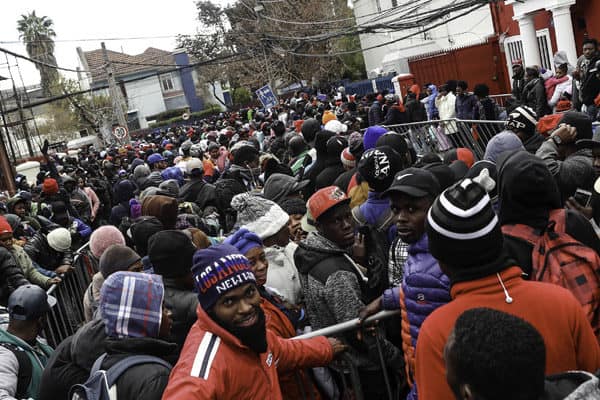
Haitian immigrants queue in front of their embassy in Santiago, Chile, 17 July 2018, to legalize their migratory status. (Credit Image: © Alberto Valdos/EFE via ZUMA Press)
Along with Uruguay and Costa Rica, Chile is one of the most peaceful countries in Latin America; it is always among the top five. Haiti, meanwhile, is such a sh**hole that good numbers on crime are unavailable. The same is true for Bolivia, while Colombia has a murder rate of 27 per 100,000 inhabitants per year — the eighth highest in the world. Chile’s murder rate is only 3 per 100,000 inhabitants. America’s, at 5, is higher, but blacks and, to a lesser extent, Hispanics, raise the figure considerably.
The blacks from Haiti and Colombia now in Chile behave like blacks everywhere. For reasons already explained, there are no statistics on race and crime in Chile. We can infer, however, the impact made by these new arrivals by comparing absolute crime numbers before and after the immigrant population explosion. The American State Department’s Bureau of Diplomatic Security regularly puts out “crime and safety reports” for foreign nations to advise American tourists and expatriates. In 2014, their report on Chile said this:
Pickpocketing, telephonic scams, vehicular theft, and residential burglaries are far more common than violent crimes like express kidnappings, kidnapping for ransom, and random shootings, which rarely occur. Residents and tourists in Santiago are frequently victims of non-violent pickpocketing.
The same report in 2016 had some changes:
Pickpocketing, telephonic scams, vehicle thefts, and residential break-ins are the most common crimes against tourists and resident Americans. Violent crime also occurs, most often in the form of carjackings, home invasions, and muggings; express and traditional kidnappings and random shootings are almost non-existent.
Petty crime and residential burglaries (home invasions) dramatically increased in the metropolitan Santiago area in 2015. . . . According to Carabinero (local police) statistics reported in a January 2016 news story, the affluent community of Lo Barnechea, where many expatriates live due to the proximity to the international schools, “robbery with violence” (assaults) rose 52 percent. Home invasions rose 10.5 percent. Two other communities where many expatriates live and tourists stay are Vitacura and Las Condes. These communities saw a rise in “robbery with intimidation” of 38 percent and 32.5 percent, respectively. The use of violence in residential break-ins also increased in 2015. When residents are home, bats, homemade knives, and increasingly firearms are being used by burglars to intimidate.
The difference between 2014 and 2016 is probably accounted for by a few hundred thousand mestizos and blacks — there was no policy change or economic crash to explain it.
Here is a useful chart showing the spike in car-jackings during the same period:
As in the United States, mestizos, while not the same as the historic stock, are vastly preferable to blacks. Bolivia and Peru both have national average IQs on par with American blacks: 87 and 85, respectively. There is, however, still historical resentment of Chileans over their victory in the War of the Pacific. Just as many Hispanics in the United States dream of regaining the territory they lost in the Mexican-American War, so do Peruvians and Bolivians covet their long-lost territory.
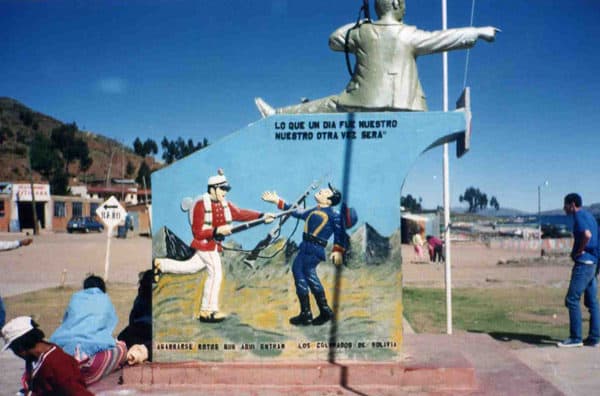
A memorial to the War of the Pacific in Bolivia. The text above the soldiers reads, “What was once ours, will be once again.” Beneath the soldiers it reads, “Hold on, Chileans, here come the redcoats of Bolivia.”
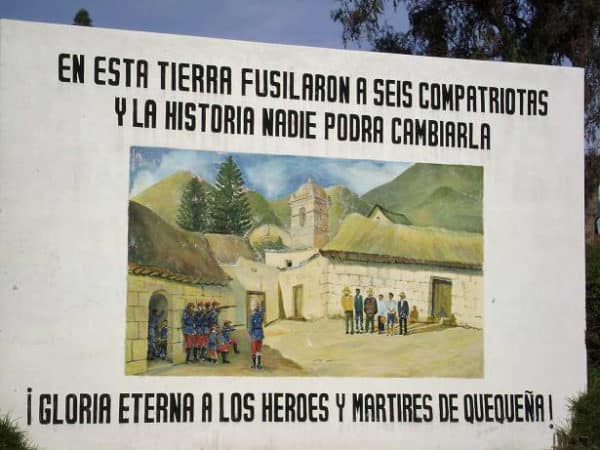
A memorial to the War of the Pacific in Peru. The text reads, “It was here that six comrades were executed — and history cannot be changed. Eternal glory to the heroes and martyrs of Quequeña.”
These new immigrants also bring diseases. By and large, Chile avoided the “AIDS crisis” of the 1980s and has always had very low rates of infection. That is starting to change now, as some estimate that the number of new HIV cases has doubled in the last decade. More conservative estimates put the increase at 79 percent since 2010. Gonorrhea rates are also soaring. From 2010 to 2015, confirmed cases were up 208 percent. Cases of syphilis, after years of holding steady, and the various strains of hepatitis, are all going up.
The fashionable explanation for this sudden jump is that because Chile is such a conservative society, its citizens lack proper education about condom use and are too embarrassed to seek treatment for sexually transmitted diseases. If that were the cause, why haven’t STD rates always been high? As with crime, the sudden spike correlates with the sudden arrival of high numbers of blacks and mestizos. Likewise, the sudden spike in infections is most apparent in regions with high numbers of immigrants: Santiago, Santiago-adjacent areas, and the northernmost third of the country, especially the city of Antofagasta.
Latin America is no exception to the global trend of blacks having much higher rates of sexually transmitted infections of all kinds than people of any other race. The Latin American nations with the highest rates of AIDS are Haiti and the Bahamas, both of which are over 90 percent black. About two percent of adults in Haiti — one person in 50 — have AIDS. After two centuries of having no Haitians, Chile now has at least 100,000 of them. That would mean about 2,000 new AIDS carriers.
I suspect, however, that many of the new infections are coming from black Colombians. Haitian immigrants are overwhelmingly male — the most reliable statistic putting it at 68 percent. While I cannot find a similar breakdown for Colombian immigrants, I am confident it is much more balanced. And while Colombian men specialize in drug dealing, the women specialize in prostitution. I cannot find hard numbers on this either, but in walking around Santiago, it is quite apparent that Colombian women — especially black ones — are common in the “red light” areas. (The different black populations in Chile, while not always easily distinguishable at first glance, are easily distinguished by their accents — the same is true, though less markedly, with the mestizos.) In the northern mining city of Antofagasta — second only to Santiago in number of recent immigrants — a local politician made headlines in 2014 for saying that the city’s recent rise in gonorrhea, syphilis, and AIDS was obviously caused by Colombian (no race specified) prostitutes, “who, by the way, are very beautiful maidens.” (Here are his comments, in Spanish).
Surprisingly, there has been no uptick in tuberculosis (TB) over the last few years. Chile’s infection rate varies between 14 and 16 per 100,000 people per year, which is about 2,000 cases a year. This is low, on par with Japan.
However, here are the rates of TB infection per year per 100,000 people in countries that send Chile most of its immigrants:
| Haiti | 188 |
| Peru | 117 |
| Bolivia | 114 |
| China | 64 |
| Dominican Republic | 60 |
| Ecuador | 50 |
| Brazil | 42 |
| Colombia | 32 |
| Venezuela | 32 |
| Argentina | 24 |
The only two countries sending a large number of immigrants to Chile that have lower rates of TB than Chile are Spain (10) and the United States (3) — and their contributions to the immigration stream are dwarfed by those of Peru, Bolivia, etc. It therefore seems almost certain that Chile will see a serious increase in TB cases in the coming years. That is precisely what happened in the United States during Barack Obama’s presidency, when unscreened/insufficiently screened “refugees” with TB were settled in America on more than one occasion, leading to TB rates going up instead of down for the first time in 23 years. This possibility is of even greater concern in Chile, which has a medical infrastructure inferior to America’s.
Racial consciousness in Chile
These are all troubling trends, but there are also reasons for optimism. Chileans have a strong sense of race just beneath the surface. The connection between race and class, with whites dominating the upper classes and mestizos dominating the lower classes, is understood and largely accepted by nearly every Chilean. The best evidence of this comes from egalitarian whining. One blogger has a neat summary of the typical conversation about race between Americans and Chileans:
Chilean person: There are real race issues in the [United] States.
Me: Yes, there are huge problems. But I think race is a problem here.
Chilean: No, we don’t have race issues here. We do have issues with class.
Me: What do you mean.
Chilean: Well, people of lower class are really looked down upon.
Me: How can you tell who these people are?
Chilean: You just can.
Me: (finding a darker skinned Chilean in the crowd) What about that person … over there … what class are they?
Chilean: They are lower class.
The whiter the Chilean, the more proud and protective they are of their whiteness. Marriages between different economic classes are uncommon, and this protects the European stock of the upper classes. Demonstrating this empirically is difficult, but the signs are very clear. Another leftist blogger noted in 2015 that:
A few years ago there was a study in Chile that consisted [of] presenting ten images of people with different skin colors and asking people to identify the subjects as Chileans or not. There was a tendency [of] identifying light skinned subjects as Chileans and darker skinned ones as Mapuches [Araucanos] (a Chilean indigenous group), Peruvians, or “foreigners.”
In the Chilean media, stories and studies about the terrible discrimination Peruvians face make the rounds every few years. While these “human interest” pieces are always written in an obnoxious, breathless liberal tone, they are, by and large, true. Chileans have always been very aware of race — even if not explicitly. The recent arrival of Haitians has intensified this consciousness. While they have served as an excuse for academics and journalists to decry racism, the not-quite-silent majority is not deceived. Just as elsewhere in the West, the comments on online articles show the common sense of most readers.
One article from 2016 I came across was titled, “The Arrival of Haitian Immigrants in Chile Has Lit Racism’s Fuse.” One commenter wrote, “Haitians first invade and then want to be accepted. Deport them all. The world doesn’t want them.” Another wrote, in part, “… they’re rejected because they are culturally different, as we all know, not every rejection of blacks is because of racism, if they were white and had the same customs, culture, religion, and manner of invading and devastating places, they would be rejected. Give them time and they will eat every animal and bird, and deforest entire areas.” Another commenter wrote that, “The natural idea of the basis of a country and society is to accept immigration that steadily adopts the values of the country, not immigration that in one fell swoop upsets the national identity . . . . Are not visas inherently discriminatory? Some get them, some don’t. Do you not have a right to decide what visitors you receive in your own home?”
Chileans are also very proud of their country’s many European cultural and historical figures. Chile’s two foremost Founding Fathers were very white, Bernardo O’Higgins (Irish) and José Miguel Carrera (Basque), as were all of the major political figures, Left and Right, of the 20th century: the Alessandri family (Italian), Pedro Aguirre Cerda (Basque), Salvador Allende (Belgian and Basque), Patricio Aylwin (Irish and Basque), and Augusto Pinochet (French and Basque). The post-independence immigrant group to have by far the greatest impact in Chile is the Germans. Throughout Chile (and especially in the mid-south), one sees very obviously German architecture and civic groups. Here are some photos of this that I took in the southern city of Frutillar:


“German Club”
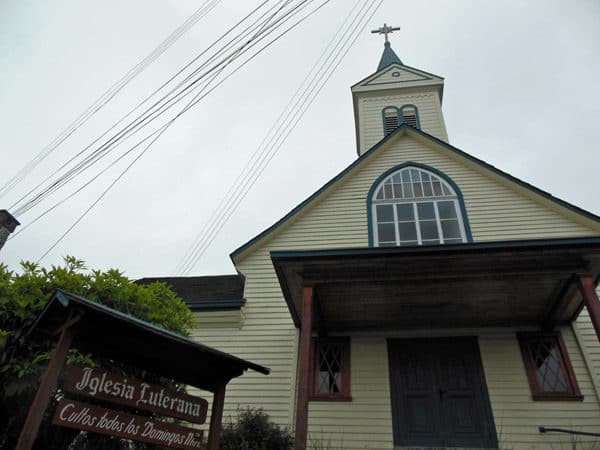
A German Lutheran Church.
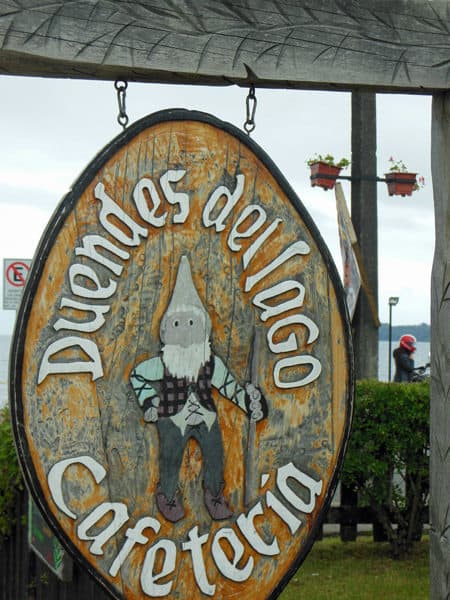
“Gnomes by the Lake Cafeteria”
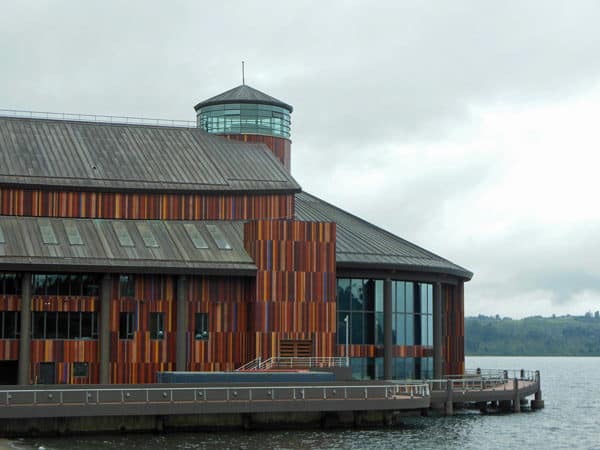
One of the world’s southernmost opera houses.
When polled, at least a third of Chileans have openly race realist views, and all polls about racial matters under-represent how many people hold “racist” opinions because many people are unwilling to admit them to a pollster. In this United States this is called the “Bradley effect.” Here are some results from a 2003 poll of Chileans about Peruvians, the largest and most historically salient non-white immigrant group.
- Chile is more developed than its neighboring countries because it has less indigenous population. (agree 34.1 percent, disagree 65.9 percent)
- The problem of opening up to the Latin American immigration is that many of them (Latin American immigrants) are indigenous. (agree 35.8 percent, disagree 64.2 percent)
- Some races are better than others” (agree 32.9 percent, disagree 67.1 percent)
- If Peruvians get too mixed with Chileans the quality of our people will worsen (agree 33.4 percent, disagree 66.6 percent)
- Peruvian immigrants that come to our country are more likely to commit crimes (agree 43.8 percent, disagree 56.2 percent)
Chile now even has an identitarian movement, called Identitarian Action Chile, clearly modeled after those in Western Europe and the United States. Their symbol is El Torreón, an 18th century fort built to defend the southern city of Valdivia (named for Pedro de Valdivia, the conquistador) against the Araucanos. Though still small, the group appears to be growing. It holds regular marches, demonstrations, and leafleting campaigns against immigration and for a Chile-first economy. Just as America’s Identity Evorpa seeks to raise awareness about the murders of women such as Kate Steinle and Justine Damond, Identitarian Action Chile raises awareness of murders committed by immigrants, such as Margarita Ancacoy, who was recently beaten to death by a gang of Ecuadorians.
Antofagasta is experiencing a sudden nativist backlash as well. In late 2013, when Colombia defeated Chile in a soccer match for the World Cup, Colombians in the city celebrated in the streets, and several fights broke out with native Chileans. Since then, the group Antofa Seguro (“Secure Antofagasta”) was founded to pressure politicians to do something about rising crime rates, drug trafficking, and public schools flooded with immigrants. Much like the “Remembrance Project” in the United States, the group leads marches and demonstrations highlighting the deaths of citizens caused by immigrants.
Antofagasta has long been a bastion of Chile’s leftist labor movement, but because of immigration, this is starting to change. In 2012, Karen Rojo, a leftist, won the mayoral election with 47.9 percent of the vote. Marcela Hernando came in second with 29.1 percent of the vote — and she was a leftist as well, and had been the previous mayor. In 2016, Mayor Rojo narrowly won reelection with just 28.1 percent of the vote. In second place, with 22.2 percent of the vote, was Manuel Rojas, an immigration restrictionist and member of Chile’s rightmost mainstream party, the Independent Democratic Union. The change was caused by the issue of immigration, which Mayor Rojo refuses to deal with seriously, simply issuing platitudes such as, “The city of Antofagasta was formed by immigrants and nobody can deny that. There is work that Chileans no longer want to do.”
Immigrants certainly do things Chileans do not, such as setting up Brazilian favela-like shanty towns, dealing drugs, prostitution, and expressing hatred for the city’s historic population.
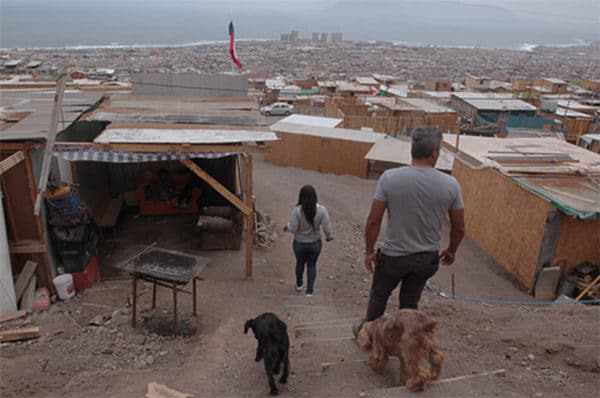
Migrant camp in Antofagasta.

Narcotics seized in Antofagasta.
More than one Chilean has advised me to stay away from Antofagasta, saying that the city has been transformed into a den of criminals, and that the only difference between it and Africa is the absence of elephants. In the last several years Antofagasta has become a key stopover for drug smugglers bringing cocaine and marijuana from Chile’s northern neighbors. Though a lot of these drugs are destined for the rest of Chile, plenty go to Chilean ports and thence to the American West Coast. Whenever Mexico and the United States intensify their drug war, this drug route picks up the slack. There are frequent, large drug arrests in this part of the country. Just a last July, anti-narcotics police in Chile seized 2.2 million dollars worth of drugs coming in from Colombia.
The return of Sebastián Piñera
Another sign of hope was the result of the last presidential election, during which center-right candidate and former president Sebastián Piñera made law and order a central issue of his campaign. In debates and interviews, he regularly displayed a graph that showed the problem of rising crime:

Mr. Piñera with his Nixonian bars.
Many members of the media mocked Mr. Piñera’s graph, and tried to discredit it, but Mr. Piñera promised to crack down not only on crime in general, but on illegal immigrants, drug traffickers, and human smugglers. Clearly aping President Trump, in 2016 Mr. Piñera said, “Chile should be open to receiving immigrants who contribute to our nation’s prosperity, but should absolutely close its borders to drug trafficking, crime, contraband, organized crime, and illegal immigration.” He went on to say, “Many of the criminal gangs in Chile today, such as those that specialize in identity theft, are made up of foreigners. This is a particularly grave situation for the areas where immigrants are a large percentage of the population.”
Another probable reason for Mr. Piñera’s appeal was his forthright position on Araucano violence. Unlike leftists who waffled, calling it highly regrettable, Mr. Piñera said forthrightly that it should be formally labeled as terrorism. This designation would mean the government could take much sterner measures to put it down.
Chile’s presidential elections work as in France: if no candidate wins over 50 percent of the vote in the first round, there is a runoff vote with only the top two vote-getters. In the first round of 2017, there were two right-wing candidates and six from the left. With so many candidates, nobody won over 50 percent in the first round, but Mr. Piñera made it into the second round. On election day, he won by nearly ten points, and his victory clearly reflected the importance of immigration.
The regions most affected by immigrants are the massive capital city region of Santiago, its two neighboring regions, and the northern third of Chile — especially Antofagasta. Mr. Piñera carried all of these regions in the second round, and all but one by a large margin. The Araucania went to Mr. Piñera by the biggest margin of any region, with his opponent winning only 37.6 percent of the vote there — just a bit higher than the percentage of the population that is Araucano. The two regions next to Araucania went for Mr. Piñera by comfortable margins as well. He lost only the whitest southern regions — which are all but untouched by immigration and Araucano violence — and the absentee vote, which is dominated by leftists who fled Gen. Pinochet’s regime and never returned. Chileans who know about Amerindians and immigrants firsthand are most likely to vote for the Right.
This is Sebastián Piñera’s second term as president. In 2009-2014, during his first term, he was much more like Mitt Romney and much less like Donald Trump. His platform was center-right “economism,” and he won by only three points — mainly because the Left’s candidate was the decidedly uninspiring and mediocre former President Eduardo Frei Ruiz-Tagle. Mr. Piñera’s first time in office was uninspiring. I lived in Chile for part of his first term, and it seemed that the entire country hated him. I myself always thought of him as something of a doofus — a man without any sense of social grace or political tactics.
Yet only a few years later, after another scandal-ridden leftist president, a wave of immigration, crime, and unrest in the Araucania, President Piñera returned to politics more as a Trumpian nationalist. His victory and general popularity speak for themselves and should be a lesson to the Right throughout the West. He took office only in March of this year, so it is too early to tell if President Piñera will dedicate the resources, political capital, and moral courage needed to curb the immigration that candidate Piñera deplored. In any case, he will certainly be better than any leftist. Like President Trump, President Piñera even shows furtive signs of racial consciousness. During his first term, he once said, on camera, to the father of a small blonde child, “Congratulations, you’ve done a great thing, you’re bettering the race.”
There are a number of things the new president should do.
The north and northeastern border should be militarized: more walls, more patrols, more checkpoints, and more soldiers. Plenty of illegal drugs pour through the northern border, so more security kills two birds with one stone — just like better security on America’s southern border. From east to west, Chile is a very small country, so it should be easy to secure the border to the north — especially given Chile’s wealth and military prowess.
Chile should round up illegal immigrants and deport them, as the Israelis do.
Immigration from white and whitish countries should get preference, under one guise or another. Venezuela is not as white as Chile, but is still whiter than most Latin American nations. Although the population is mixed, on the whole, it is reasonable to assume Venezuelans are an assimilable people, especially since those fleeing today are mainly upper, whiter, professional classes. All the Venezuelans I have met in Chile were polite, hardworking, and grateful to have left a nation committing suicide by Marxism. Communism has brought more death and poverty to Latin America than any European power, and Latin Americans should help each another escape from and defeat it. During Chile’s own chaotic period from 1970 until 1990, Venezuela took in an estimated 80,000 Chileans — including the famous novelist Isabel Allende. In fact, so many Chileans reached Venezuela that there is now a whole community of Venezuelan-Chileans there, including the actress Ana Karina Casanova. Chile should return the favor, and maybe even invite Henrique Capriles, perhaps Venezuela’s most courageous dissident, to set up a government in exile.
Although Argentina is not as white as it used to be, it is still much whiter than Bolivia and Peru. Like Venezuela, there are economic reasons to give Argentinians preferential immigration status — which can serve to mask the racial reasons that should earn them preferential immigration status. Chile and Argentina have much in common, and have traded waves of immigrants back and forth since the 19th century. Spain, the motherland, has also been in an economic rut for a decade now — which is why there is already a steady flow of Spanish immigrants. Spain is also unarguably whiter than Chile, so a large stream of Spaniards would be a plus for Chile, not roughly neutral as with Venezuela and Argentina. Of great importance is that Venezuela, Argentina, and Spain have all had lengthy periods of great prosperity and cultural achievement. Their current hard times, of which Chile has certainly had its fair share (it was the country hardest hit by the Great Depression) are almost certainly temporary. They have the necessary genetic makeup to build and sustain modern and comfortable societies. There is no evidence for this in Peru, Bolivia, or Haiti.
Right now, President Piñera, who is a fervent anti-Communist, has boldly proposed making immigration easier for Venezuelans (in the name of democratic solidarity) and harder for Haitians (because of its high rates of “irregularity”). Let us hope he increases Argentine and Spanish immigration, and limits Colombian and Dominican immigration.
Chinese immigration should also be halted, largely for security reasons. China wants to be puppet master in Latin America almost as much as in Africa. The last thing Chile needs is a bright Asian fifth column in its military and intelligence agencies, as the United States is certainly headed down that path. Nor should Chile seek to import an alien Asian elite, as Peru accidentally did.

Alberto Fujimori, President from 1990 until 2000 … of Peru.
In sum
From a strict purist Anglo-Nordic perspective, Chile is not an especially white nation. Perhaps only 10 percent of Chileans are 95 percent or more white. If you lumped together all the pure Amerindians, Asians, Middle Easterners, Mizrahi Jews, and Gypsies, the non-white population is around 20 percent. Another 10 percent are very dark mestizos. The remaining 60 percent are castizo or mestizo. However, by the standards of Latin America, Chile is considered white, and objectively it is much whiter than almost every other country in the region.
Chile is a great country. Though small and isolated, it has produced great figures in the fields of literature, poetry, film, music, athletics, and economics. It has fought heroic wars and conquered and tamed some of the most difficult terrain on the planet: from the polar south, to the driest desert in the world in the north, to the Andes mountain range. Its historic people are physically beautiful, warm, well cultured, and highly literate. As with other international outposts of Europeans, from the Boers of South Africa, to the Anglos of Australia and New Zealand, to the confederados of Brazil, to the remnants of America’s historic majority still in the United States, they deserve to thrive, for themselves and for their prosperity. The choices they make in the coming years may well determine their fate. Let us pray they choose well.

